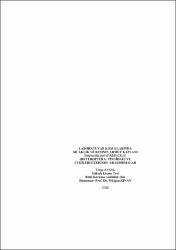| dc.contributor.author | Aysal, Tolga | |
| dc.date.accessioned | 2017-04-20T07:33:15Z | |
| dc.date.available | 2017-04-20T07:33:15Z | |
| dc.date.issued | 2008 | |
| dc.identifier.uri | https://hdl.handle.net/20.500.11776/235 | |
| dc.description.abstract | Sıcaklığın ve bazı konukçu bitkilerin S. pyri üzerindeki etkilerini saptamak amacıyla, 2006 yılında Namık Kemal Üniversitesi, Ziraat Fakültesi, Bitki Koruma laboratuvarlarında bir çalışma yürütülmüştür. Sıcaklıkla ilgili çalışmalar, 20±1, 23±1, 26±1, 29±1 ve 32±1 ºC'ler olmak üzere beş farklı sıcaklıkta, 16/8 saatlik aydınlatmalı koşullarda, elma yaprağı üzerinde yapılmıştır. Konukçular ile ilgili çalışmalar 26±1 ºC sıcaklıkta, aynı koşullarda yürütülmüş, farklı konukçular olarak elma (Pyrus malus L.), kiraz (Prunus avium L.) ve ateş dikeni (Pyracantha coccinea M. Roem.) (Rosaceae) yaprakları kullanılmıştır. Denemede tüm sıcaklıklar içerisinde; ergin ömrü, ovipozisyon süresi, yumurta açılma süresi, yumurtadan ergine gelişme süresi ve cinsiyetlere göre nimf gelişme süresi, en kısa 20 °C'de, en uzun 32 °C'de kaydedilmiş ve bu sürelerin sıcaklığın artması ile kısaldığı tespit edilmiştir. Denenen tüm sıcaklıklarda dişilerin erkeklerden daha uzun süre yaşadığı belirlenmiştir. Elde edilen bulgulara göre Armut kaplanı için en uygun sıcaklığın 26 °C olduğu saptanmıştır. 26 °C'de, ergin ömrü erkek ile dişilerde sırasıyla 16.4±1.9 ve 35.5±2.4 gün, ovipozisyon süresi 28.5±2.5 gün, yumurta verimi 186.9±15.3 yumurta, yumurta açılma süresi 9.9±0.1 gün, yumurtadan ergine gelişme süresi 22.4±0.3 gün olarak kaydedilmiştir. Armut kaplanının 20, 23, 26, 29 ve 32 °C'lerde dişi oranının sırasıyla % 42, % 35, % 52, % 43 ve % 78 olduğu bulunmuştur. Gelişmesini tamamlayan bireylerde, % 48.6 oranı ile en yüksek ölüm 32 °C'de elde edilmiştir. Dişilerin ömrü sıcaklık denemelerine benzer şekilde ve tüm konukçu bitkilerde erkeklere göre daha uzun bulunmuştur. Elma yaprakları ile beslenen armut kaplanında ergin ömrü erkek ile dişilerde sırasıyla ortalama 16.4±1.9 ve 35.5±2.4 gün, kiraz yaprağı ile beslenenlerde sırasıyla 13.5±1.4 ve 23.2±1.5 gün olarak kaydedilmiştir. Elma yaprağında beslenen dişilerin ovipozisyon süresi 28.5±2.5 gün, kiraz yaprağı ile beslenen dişilerin ise 15.4±1.5 gün olarak belirlenmiştir. En yüksek yumurta verimi 186.9±15.3 yumurta olarak elma üzerinde beslenen dişilerde elde edilmiştir. Yumurta açılma süresi elma, kiraz ve ateş dikeninde sırasıyla 9.9±0.1, 11.9±0.1 ve 10.9±0.4 gün olarak saptanmıştır. Yumurtadan ergine gelişme süresi en kısa 22.4±0.3 gün ile elmada tespit edilirken bunu 23.4±0.2 gün ile kiraz takip etmiştir. Ölüm oranları denenen tüm konukçularda benzer değerler olarak kaydedilmiştir. Armut kaplanının elma, kiraz ve ateş dikeninde dişi oranı sırasıyla % 52, % 61 ve % 42 olarak bulunmuştur. Elma ve kirazın ateş dikenine göre S. pyri için daha uygun konukçular olduğu belirlenmiştir. | en_US |
| dc.description.abstract | This study which aimed at determining the effects of temperatures and some host plants on S. pyri was conducted under the laboratory conditions at Namık Kemal University, Faculty of Agriculture, Department of Plant Protection in 2006. The aim of study was the determination of some biological structures of S. pyri by effect of different temperatures and hosts. The studies about temperatures were done in five different temperatures (20±1, 23±1, 26±1, 29±1 and 32±1 ºC) and 16:8 h photoperiod on apple leaves. The studies about hosts were conducted same photoperiod conditions at 26±1 ºC. Leaves of apple (Pyrus malus L.), cherry (Prunus avium L.) and firethorn (Pyracantha coccinea M. Roem.) were used as host plant. The shortest and longest time period in all temperatures was recorded by mature age, oviposition period, incubation period, growth period from egg to mature and nimf premature period by sex were at 20 and 32 °C, respectively and the time periods were became shortest by increase of temperatures determined. It was determined that female lived longer than male. By the results, the most available temperature for Pear lace bug was 26°C suggested. In 26°C temperature, mature age for male and females were 16.4±1.9 and 35.5±2.4 days respectively, oviposition period was 28.5±2.5 days, fecundity was 186.9±15.3 eggs, incubation period was 9.9±0.1 days and growth period from egg to mature age was 22.4±0.3 days recorded. The sex rates for females in 20, 23, 26, 29, and 32 °C temperatures were 42%, 35%, 52%, 43% and 78% respectively. The highest survival rate for per individuals which were reached mature was 48.6 % at 32 °C. Longevities of females were similar with studies on different temperatures and longer than males on all tested host plants determined in this of different temperatures. An average longevity for male and females were recorded as 16.4±1.9 and 35.5±2.4 days, respectively, for Pear lace bug feed on apple leaves, 23.2±1.5 and 13.5±1.4 days respectively on cherry leaves. Oviposition period was determined 28.5±2.5 days for females feed on apple leaves, 15.4±1.5 days on cherry leaves. It was determined the highest fecundity 186.9±15.3 eggs by females feed on apple leaves. Incubation period for apple, cheery and firethorn leaves were determined 9.9±0.1, 11.9±0.1 and 10.9±0.4 days respectively. The shortest growth period from egg to mature was determined 22.4±0.3 days for apple leaves and 23.4±0.2 days for cherry respectively. The survival rates for total nimf periods were very similar values to all hosts tested. The sex rates for females in apple, cherry and firethorn were 52%, 61% ve 42% respectively. It was suggested that apple and cherry were the most available hosts. | en_US |
| dc.language.iso | tur | en_US |
| dc.publisher | Namık Kemal Üniversitesi | en_US |
| dc.rights | info:eu-repo/semantics/openAccess | en_US |
| dc.subject | Stephanitis pyri | en_US |
| dc.subject | biyoloji | en_US |
| dc.subject | sıcaklık | en_US |
| dc.subject | konukçu | en_US |
| dc.subject | biology | en_US |
| dc.subject | temperature | en_US |
| dc.subject | host | en_US |
| dc.title | Laboratuvar koşullarında sıcaklık ve besinin armut kaplanı Stephanitis pyri (Fabricius) (Heteroptera:Tingidae)'ye etkileri üzerinde araştırmalar | en_US |
| dc.title.alternative | Investigations on effects of tempereature and food on Stephanitis pyri (Fabricius) (Heteroptera:Tingidae) in the laboratory conditions | en_US |
| dc.type | masterThesis | en_US |
| dc.department | Enstitüler, Fen Bilimleri Enstitüsü, Bitki Koruma Ana Bilim Dalı | en_US |
| dc.relation.publicationcategory | Tez | en_US |



















